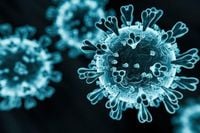As the world continues to grapple with the evolving landscape of COVID-19, a new variant known as NB.1.8.1, or "Nimbus," has emerged as a focal point of concern and vigilance. First detected in January 2025, this Omicron subvariant has rapidly spread across 22 countries, including India, Ireland, the United Kingdom, the United States, and several Asian nations such as China, Thailand, and Indonesia. Despite its swift transmission, health authorities emphasize that NB.1.8.1 does not currently pose a heightened risk of severe illness compared to previous strains.
India, in particular, has seen a notable surge in active COVID-19 cases, with the Union Health Ministry reporting 6,491 active infections as of June 9, 2025. Kerala remains the most affected state, accounting for 1,957 cases as of June 6, followed by Gujarat with 980, West Bengal at 747, and Delhi with 728 cases. This rise coincides with the detection of NB.1.8.1 within the country, including a confirmed case in Tamil Nadu in April. Additionally, Gujarat reported four cases of another subvariant, LF.7, in May.
Globally, the World Health Organization (WHO) has designated NB.1.8.1 as a "Variant Under Monitoring" (VUM) as of May 23, 2025, reflecting the need for close observation without signaling immediate alarm. The variant accounted for 10.7% of global COVID-19 sequences submitted to the GISAID database by late April 2025, a significant increase from just 2.5% a month earlier.
Scientists have identified that NB.1.8.1 possesses mutations in its spike protein that enhance its binding affinity to the human ACE2 receptor, potentially making it more transmissible than earlier variants. Virologist Lara Herrero from Griffith University highlighted that laboratory models indicate NB.1.8.1 may infect cells more efficiently, suggesting why it has spread rapidly across regions such as China, Australia, and parts of the United States. Despite this increased transmissibility, early evidence indicates the variant does not lead to more severe disease.
Common symptoms associated with NB.1.8.1 include the familiar COVID-19 signs of sore throat, fatigue, mild cough, fever, muscle aches, and nasal congestion. However, several reports have noted unusual gastrointestinal symptoms such as nausea, vomiting, diarrhea, bloating, heartburn, constipation, and abdominal pain, which are less typical of earlier COVID-19 strains. The Irish Health Service Executive (HSE) has issued guidance urging those unwell to stay home until 48 hours after symptoms have mostly or fully resolved, with specific protocols for returning to work or school following positive tests.
In the United Kingdom, 13 cases of NB.1.8.1 have been confirmed, mainly through airport screenings and subsequent community detection. The UK Health Security Agency reported a 10.1% increase in COVID-19 cases up to the week ending May 28, 2025, alongside a 5.9% rise in deaths and a 3.5% increase in hospitalizations. Despite these upticks, the dominant variant in the UK remains LP.8.1, with NB.1.8.1 under close surveillance.
Healthcare professionals stress that current COVID-19 vaccines continue to offer robust protection against severe illness and hospitalization caused by NB.1.8.1. The Global Virus Network (GVN), an international coalition of leading virologists and research centers, underscores that there is no evidence suggesting this variant causes more severe disease than previous strains. Treatments such as Paxlovid and remdesivir remain effective against this and other Omicron subvariants.
Vaccination remains a critical tool in managing the ongoing pandemic. The GVN recommends that adults over 65 and individuals with underlying health conditions receive updated boosters tailored to circulating variants. Moreover, everyone aged six months and older is encouraged to stay current with vaccinations, particularly ahead of respiratory illness seasons in autumn and winter. Pregnant individuals, children, and teenagers are also urged to receive appropriate vaccine doses to mitigate risks such as hospitalization and multisystem inflammatory syndrome in children (MIS-C).
India has taken proactive measures to address the recent surge by conducting facility-level mock drills to assess hospital readiness, including oxygen supply systems and equipment availability. Hospitals are instructed to adhere to the revised ABC Guidelines 03 for treating patients exhibiting symptoms of influenza-like illness, acute respiratory infection, or severe acute respiratory infection. Testing protocols mandate that all symptomatic patients undergo rapid antigen testing followed by RT-PCR if necessary, ensuring timely diagnosis and care.
Experts caution that COVID-19 will likely remain endemic, with periodic flare-ups influenced by factors such as seasonality, population immunity, and viral mutations. Dr. Sylvia Karpagam, a public health expert in India, emphasizes the importance of a robust public health system focused on prevention and preparedness rather than reactive measures. She warns against complacency, noting, "We thought polio was contained, but suddenly it surged because it was a new form of polio. So, lab checking, taking samples, and constant research must be done."
The WHO’s recent strategic documents, including the "Strategic and Operational Plan for Coronavirus Disease Threat Management: 2025–2030," advocate for targeted, evidence-based responses over disruptive measures such as lockdowns or broad travel bans. The focus is on early variant detection, focused vaccination campaigns, and transparent communication to maintain public trust and prevent misinformation.
As the global community adapts to this evolving phase of the pandemic, health authorities urge continued vigilance without panic. Good hygiene practices, mask-wearing in crowded indoor spaces during surges, and timely vaccination remain essential. The emergence of NB.1.8.1 serves as a reminder that while the virus continues to mutate, the tools developed over the past years—vaccines, treatments, and public health strategies—remain effective in protecting populations worldwide.






